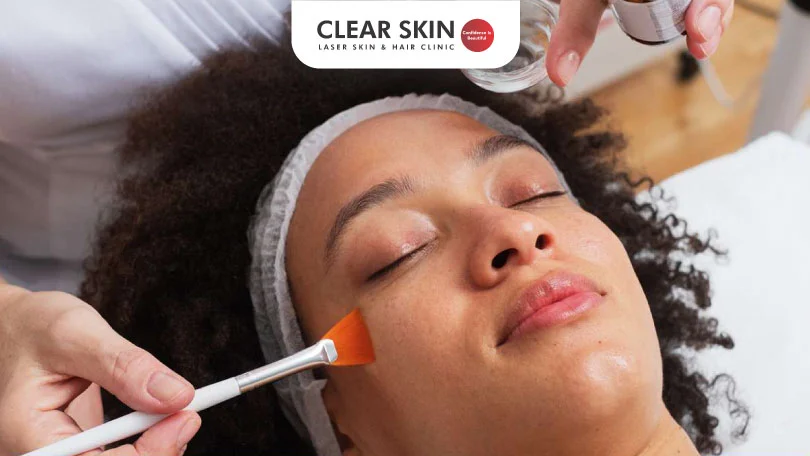Blogs /Chemical Peels for Acne Scars: Benefits, Types, and Treatment
Chemical Peels for Acne Scars: Benefits, Types, and Treatment
Reviewed By: Dr. Dhanraj Chavan
Updated on: 30 July, 2024

Acne Peels are one of the most commonly adopted treatment methods for treating acne scars. But are they really effective? How exactly do they work? It’s time to find out the answers. Are you struggling with acne scars and looking for effective treatments? In this blog, we will dive into the benefits of chemical peels for treating acne scars. We will also discuss various types of acne scars, and explain how chemical peels fit into a comprehensive acne scar treatment plan.
Table Of Content
- What Are Acne Scars and Their Types?
- How Do Chemical Peels Work for Acne Scars?
- What Role Do Chemical Peels Play in Treating Acne Scars?
- How to Prepare for a Chemical Peel?
- What to Expect During and After a Chemical Peel?
- Are There Any Risks or Side Effects?
- How Effective Are Chemical Peels for Acne Scars?
- Conclusion
What Are Acne Scars and Their Types?
Acne scars are the result of inflamed blemishes caused by skin pores engorged with excess oil, dead skin cells, and bacteria. When these blemishes swell, they break the follicle wall, leading to the formation of scars. Acne scars can be broadly classified into two categories:
Post-Inflammatory Hyperpigmentation (PIH)
PIH refers to the dark spots that remain on the skin after an acne lesion has healed. These spots can be brown or black and are caused by an overproduction of melanin in response to inflammation. PIH is not a true scar but rather a discoloration that can fade over time with proper treatment.
Atrophic Scars
Atrophic scars are indentations or depressions in the skin that result from severe acne. They occur when the skin is unable to regenerate tissue, leaving behind uneven skin texture.
Atrophic scars can be further divided into three types:
✔ Ice Pick Scars: Narrow, deep scars that extend into the dermis, resembling puncture wounds.
✔ Boxcar Scars: Broad, box-like depressions with sharp edges.
✔ Rolling Scars: Wide depressions with rounded edges that give the skin a wavy appearance.
How Do Chemical Peels Work for Acne Scars?
Chemical peels involve applying a chemical solution to the skin, which causes it to exfoliate and eventually peel off. This process removes the outermost layers of dead skin cells, revealing new, smoother skin underneath.
Chemical peels can be classified into three types based on their depth of penetration:
Superficial Peels
Superficial peels penetrate the outer layer of the skin (epidermis) and are effective for treating mild acne scars, superficial pigmentation, and improving overall skin texture. Common acids used in superficial peels include glycolic acid, lactic acid, and salicylic acid.
Medium Depth Peels
Medium depth peels penetrate the middle layer of the skin (dermis) and are used for more severe acne scars and pigmentation. These peels often use trichloroacetic acid (TCA) or stronger concentrations of glycolic acid.
Deep Peels
Deep peels penetrate the deeper layers of the dermis and are used for the most severe acne scars. Phenol peels are an example of deep peels, but they are rarely used due to their potential side effects and longer recovery time.
What Role Do Chemical Peels Play in Treating Acne Scars?
Treating Pigmented Acne Scars
Chemical peels are particularly effective for treating pigmented acne scars, such as PIH. Superficial and medium depth peels can remove the outer layers of the skin where pigmentation resides, helping to lighten dark spots and improve skin tone. By reducing melanin production and accelerating skin cell turnover, chemical peels can significantly diminish the appearance of pigmented scars.
Stimulating Collagen Production
For atrophic scars, chemical peels can help stimulate collagen production, which is crucial for skin repair and regeneration. Medium depth and deep peels penetrate the dermis, where they promote the growth of new collagen fibers. This process helps to fill in and smooth out depressed scars, improving skin texture and reducing the depth of the scars.
Combining Peels with Other Treatments
In cases of severe acne scars, chemical peels can be combined with other treatments for more effective results. For example, a combination of chemical peels and laser treatments can address both pigmentation and texture issues. Lasers like IPL (Intense Pulsed Light) and Nd YAG can target deep pigmentation and redness, complementing the effects of chemical peels.
How to Prepare for a Chemical Peel?
Before undergoing a chemical peel, it’s essential to prepare your skin properly to ensure the best results and minimize potential side effects. Here are some tips for pre-peel preparation:
Avoid Sun Exposure
Protect your skin from the sun by wearing sunscreen and avoiding direct sun exposure. Sunburned or tanned skin can increase the risk of complications.
Discontinue Certain Products
Stop using products that contain retinoids, alpha hydroxy acids (AHAs), and beta hydroxy acids (BHAs) at least one week before the peel to reduce skin sensitivity.
Consult a Dermatologist
Always consult with a dermatologist to determine the appropriate type and strength of the peel for your skin type and concerns.
What to Expect During and After a Chemical Peel?
During the Procedure
During a chemical peel, the dermatologist will cleanse your skin and apply the chemical solution using a brush or sponge. You may feel a mild stinging or burning sensation as the solution works on your skin. The duration of the procedure depends on the type and depth of the peel.
After the Procedure
Post-peel care is crucial for optimal results and minimizing side effects.
Here’s what you should expect and do after a chemical peel:
✔ Your skin will be red and start to peel within a few days. The peeling process can last up to a week for superficial peels and longer for deeper peels.
✔ Keep your skin well-hydrated with a gentle, fragrance-free moisturizer to help soothe and protect the new skin.
✔ Continue to avoid direct sun exposure and use a broad-spectrum sunscreen with at least SPF 30 to protect your skin from UV damage.
✔ Adhere to any specific post-peel instructions provided by your dermatologist, including avoiding certain skincare products and activities.
Are There Any Risks or Side Effects?
While chemical peels are generally safe when performed by a qualified professional, there are potential risks and side effects to be aware of:
Hyperpigmentation
Darker skin tones are more prone to hyperpigmentation after a chemical peel. Proper pre- and post-peel care can help minimize this risk.
Scarring
In rare cases, deep peels can cause scarring. Choosing an experienced dermatologist can reduce this risk.
Infection
Keeping the treated area clean and following post-peel care instructions can prevent infections.
How Effective Are Chemical Peels for Acne Scars?
The effectiveness of chemical peels for acne scars depends on several factors, including the type and severity of the scars, the depth of the peel, and adherence to post-peel care. While chemical peels can significantly improve the appearance of acne scars, they may not completely eliminate them. You can combine chemical peels with other treatments, such as laser therapy or microneedling to enhance results.
Do You Know?
Roughly 250 Patients Are Treated
Everyday By These Dermatologists
(You are one click away from flawless skin)
Meet Our Dermatologist!
Conclusion
Chemical peels can be a valuable tool in treating acne scars, particularly for those with pigmented scars and mild to moderate atrophic scars. It’s very important to know how chemical peels work. This will help you make the right decision about adding them into your skincare routine.
Always consult with a qualified dermatologist at Clear Skin Clinic to determine the best treatment plan for your specific skin needs. With the right approach, you can achieve smoother, clearer skin and regain your confidence. You can talk to our experts if you need any further information on acne or any skin-related issues.
Further Reading
Is Tretinoin Cream Safe for Melasma? Tips and Usage Guide
Discover how tretinoin cream can safely treat melasma.
Unveiling the Potential of Face Packs for Acne Scars
Discover how homemade and customized face packs can help lighten acne marks and rejuvenate your skin.
Home Remedies for Acne Scars
Effective Home Remedies for Acne Scars
Salicylic Acid: Your Ultimate Guide to Banishing Acne Scars
Salicylic acid helps fade acne scars by exfoliating the skin and promoting cell renewal. Discover its benefits, effectiveness, and how to use it safely.
Have thoughts? Please let us know
We are committed not only to treating you, but also educating you.






